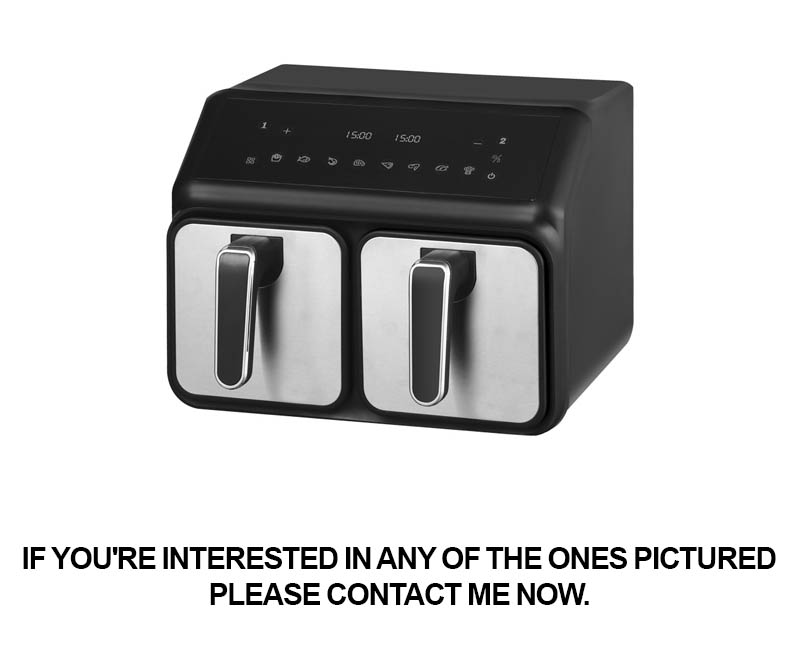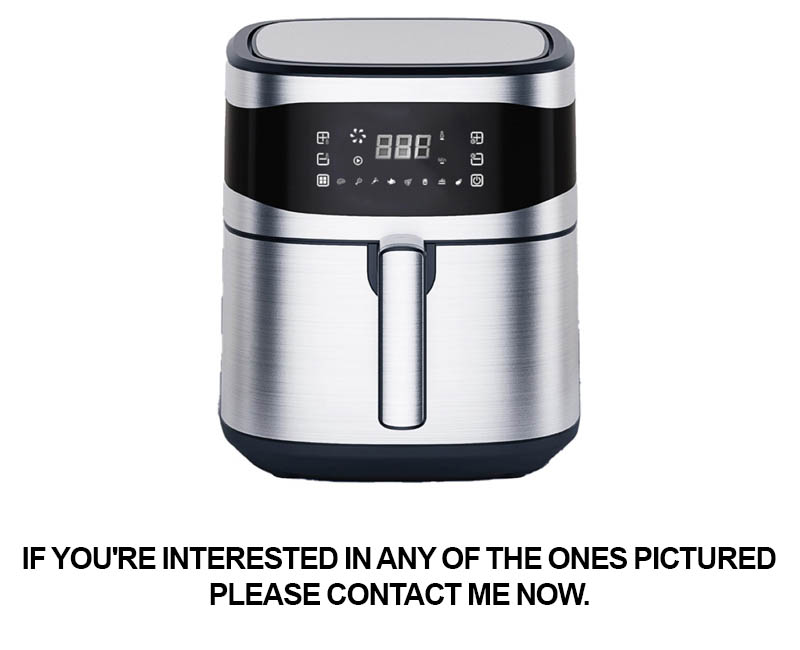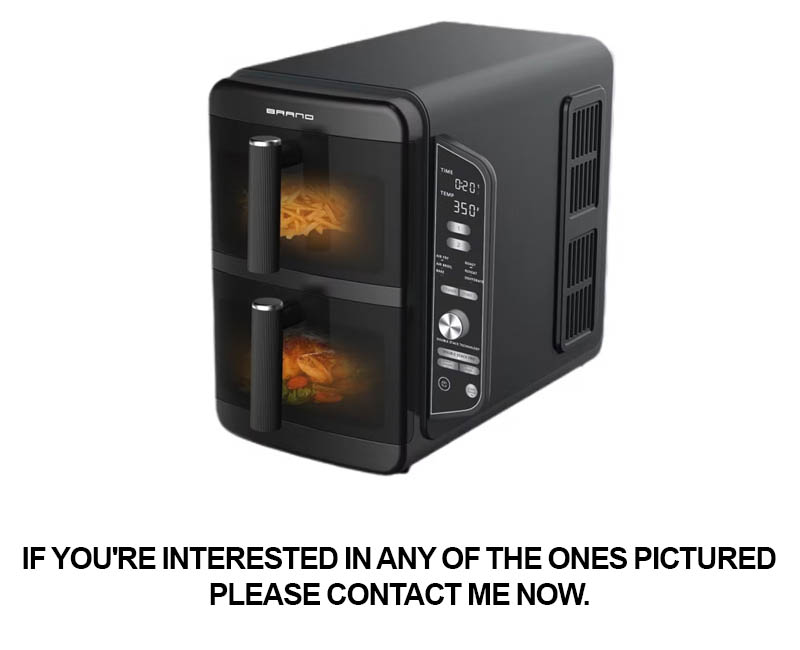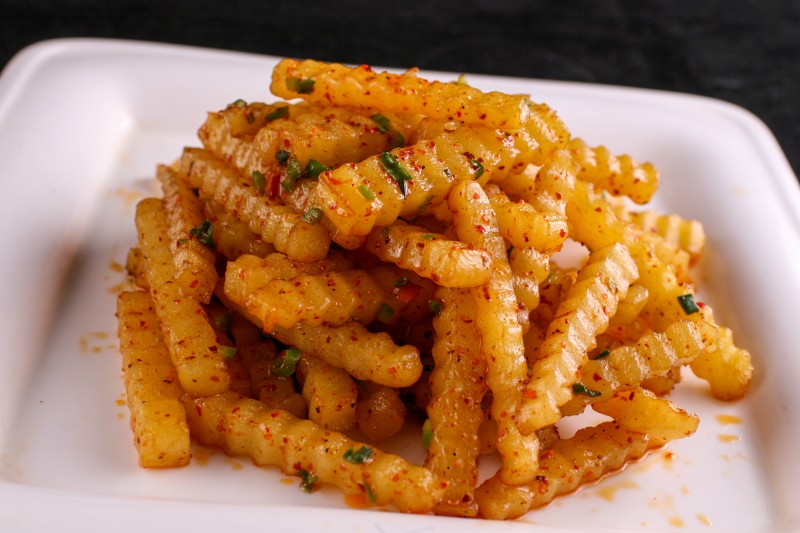Address
304 North Cardinal
St. Dorchester Center, MA 02124
Work Hours
Monday to Friday: 7AM - 7PM
Weekend: 10AM - 5PM
Address
304 North Cardinal
St. Dorchester Center, MA 02124
Work Hours
Monday to Friday: 7AM - 7PM
Weekend: 10AM - 5PM

In a world where technology meets culinary desires, modern appliances have transformed the way we cook. Among these innovations, smart kitchen gadgets have become the secret sauce to effortless meal preparation. Let’s dive into the realm of modern convenience and explore how smart features are putting the “easy” back into everyday cooking.
In the realm of kitchen appliances, speed is a prized attribute, and when it comes to quick cooking, the battle between the microwave and the air fryer is a hot topic. Let’s delve into how each of these appliances tackles the challenge of speed cooking.
The microwave is a marvel of modern convenience, a device that can transform your kitchen into a time-saving wonderland. With a touch of a button, it can heat up leftovers, reheat your morning coffee, or cook a microwaveable meal in mere minutes. It’s like having a personal chef that never takes a break, always ready to serve up a hot meal at a moment’s notice.
The microwave’s speed is unparalleled, and it’s not just about the time it takes to cook; it’s the sheer efficiency that sets it apart. Whether you’re defrosting a frozen dinner or steaming vegetables, the microwave’s rapid heat distribution ensures that food is cooked evenly, with minimal guesswork required. It’s a one-stop-shop for quick and convenient meals, making it an essential appliance for busy individuals or those looking to save time.
On the flip side, the air fryer is a newer entrant in the world of quick cooking, but it’s quickly gaining popularity. While it may not match the microwave’s instantaneous cooking power, the air fryer offers a unique method that is both healthy and efficient. By using hot air to circulate around the food, it achieves a crispy outer layer without the need for excessive oil. This not only cuts down on cooking time but also reduces the calorie count of your favorite fried foods.
In terms of speed, the air fryer is no slouch. It takes a few minutes to preheat, but once it’s up to temperature, it can cook a batch of crispy French fries or chicken wings in about 15 to 20 minutes. For those who are short on time but still want to enjoy a crispy, satisfying meal, the air fryer is a solid contender.
But let’s not forget the simplicity of the microwave. There’s no need to wait for preheating or to monitor the cooking process. Just place your food inside, set the timer, and let the microwave do its magic. The ease of use is undeniable, and for many, it’s the main draw of this appliance.
The microwave also has the advantage of being able to multitask. You can heat up a bowl of soup while simultaneously popping some popcorn in the microwave-safe bag. This dual-purpose ability is something the air fryer, with its more singular focus on air frying, can’t quite replicate.
When it comes to specific tasks, the microwave shines in areas where speed is paramount. For example, defrosting a chicken breast in the microwave is a breeze, taking only a fraction of the time it would in the refrigerator. This is especially useful when you need to cook a meal on the fly.
The air fryer, while slower than the microwave in some instances, makes up for it with its ability to cook larger quantities of food. If you’re cooking for a crowd, the air fryer can handle a bigger load, ensuring that everyone gets a share of the deliciousness without the wait.
Yet, there’s a subtle art to the microwave’s speed. While it’s fast, it can sometimes be too fast, leading to overcooking or unevenly cooked meals. Patience is key when using a microwave, and sometimes, it requires a bit of trial and error to get the timing just right.
In contrast, the air fryer may take a bit longer, but it offers a consistent and controlled cooking environment. The hot air ensures that food is cooked through and crispy on the outside, with a tender interior. It’s a method that has won over many health-conscious consumers who are looking to enjoy their favorite fried foods with a cleaner conscience.
Ultimately, the speed battle between the microwave and the air fryer boils down to personal preference and the type of cooking you enjoy. If you’re all about convenience and multitasking, the microwave is your go-to. But if you’re looking for a healthier alternative that doesn’t compromise on speed, the air fryer is the appliance for you.
In the end, both appliances have their merits, and it’s up to the individual cook to decide which one fits their lifestyle and cooking habits best. Whether you choose the microwave’s rapid response or the air fryer’s healthier approach, the key to quick cooking lies in knowing how to use these tools to their full potential.

In the world of kitchen appliances, the debate between quick and healthy cooking often centers on two formidable players: the microwave and the air fryer. While the microwave offers unparalleled speed, the air fryer has emerged as a hero in the realm of nutrient-preserving cooking. Let’s delve into how these two appliances stack up when it comes to maintaining the nutritional integrity of your food.
1. The Microwave: A Time-Saver with a Nutrient Catch
The microwave is a kitchen staple, renowned for its ability to zap meals from raw to ready in mere minutes. Its speed is unmatched, but does it sacrifice nutrients in the process? The answer is a bit nuanced. Microwaves heat food from the inside out, which can lead to some nutrients being more easily leached out. However, advancements in microwave technology have allowed for better containment of nutrients, especially when using microwave-safe containers that prevent direct contact with the microwave’s walls.
2. The Air Fryer: A Nutrient Guardian in Disguise
Enter the air fryer, a modern marvel that promises both speed and health. Unlike the microwave, which heats food with electromagnetic waves, the air fryer circulates hot air around the food, creating a crispy outer layer while keeping the inside tender. This method of cooking is much closer to traditional baking or frying, but with a fraction of the oil. The result? Foods that are not only delicious but also retain a significant amount of their original nutritional value.
3. Retaining Flavors and Vitamins
When it comes to flavor, both appliances can preserve the taste of your ingredients. However, the air fryer tends to lock in more of the natural flavors due to its gentle cooking process. This is particularly beneficial for delicate vegetables, which can lose their vibrant taste when overcooked. Additionally, the air fryer’s ability to cook at lower temperatures helps retain vitamins and minerals that are often destroyed by high heat.
4. Fats and Calories: The Battle of the Bulge
One of the most significant advantages of the air fryer over the microwave is its fat content. Traditional frying involves submerging food in oil, which can add unnecessary calories and saturated fats. In contrast, air frying uses a small amount of oil, often just a tablespoon or two, to achieve that same crispy texture. This not only makes air-fried foods healthier but also allows you to indulge in your favorite fried treats without the guilt.
5. The Science of Heat and Nutrition
The science behind heat and nutrition is fascinating. The microwave’s rapid heating can cause some nutrients to break down more quickly than in the air fryer. For instance, water-soluble vitamins like vitamin C and B vitamins can leach out more easily. On the other hand, the air fryer’s slower cooking process and lower temperatures can help maintain these vitamins. Moreover, the air fryer’s ability to cook at higher temperatures can also help activate certain enzymes and break down complex carbohydrates, making them more digestible.
6. The Versatility of Nutrient-Preserving Cooking
The air fryer’s versatility is not just limited to its health benefits. It can handle a wide range of foods, from crispy French fries to tender chicken wings, all while keeping the nutrients intact. This means you can enjoy a variety of dishes without compromising on health, making it a favorite among health-conscious individuals and families alike.
7. The Environmental Impact
Another aspect to consider is the environmental impact of cooking methods. The air fryer, being more energy-efficient than the microwave, can contribute to a smaller carbon footprint. Additionally, its lower oil usage means less waste and a reduced strain on water resources used for cleaning up after frying.
8. Conclusion: A Balanced Approach
In the battle of the kitchen appliances, both the microwave and the air fryer have their strengths. While the microwave’s speed is undeniable, the air fryer’s commitment to health and nutrition is where it truly shines. By understanding the science behind these cooking methods, you can make informed decisions about how to prepare your meals, balancing convenience with well-being. Whether you’re a busy professional or a health enthusiast, the air fryer is a valuable tool in the quest for nutrient-rich cooking.

In the world of kitchen appliances, versatility is the name of the game. Let’s dive into the diverse cooking options that air fryers offer, highlighting their adaptability like a culinary chameleon.
From Crispy Snacks to Tender Roasts
Once confined to crispy fried treats, air fryers have proven their worth beyond the realm of snacks. These versatile machines now allow you to cook tender roasts that rival those from traditional ovens. Whether it’s a juicy chicken breast or a well-seasoned beef steak, the air fryer’s hot air circulation ensures even cooking and a delicious, crispy exterior.
Baking with a Twist
Who says you can’t bake in an air fryer? These gadgets have expanded their repertoire to include baking functions. Imagine a perfectly golden, fluffy batch of cupcakes or a moist, chewy batch of cookies, all achieved with less fat and a healthier twist. The air fryer’s ability to distribute heat evenly mimics the oven, giving you bakery-quality treats without the high temperature.
Steaming to Preserve Flavors
For those who love their veggies steamed to perfection, the air fryer is a game-changer. The gentle steam that circulates within the appliance tenderizes the vegetables while locking in their natural flavors and nutrients. It’s like having a steam basket on hand, but with the added bonus of achieving that crispy texture without any oil.
Frying Without the Fats
The original purpose of the air fryer was to mimic the frying experience with a fraction of the oil. Today, it’s not just for deep-fried foods; it’s a go-to for a variety of pan-fried dishes. Think about crispy stir-fries, crispy tofu, or even pan-fried fish. The air fryer’s hot air technology gives you that same crunch without the greasy aftermath.
Cuisines Around the World
The air fryer has become a travel chef in your kitchen. It’s the perfect appliance for experimenting with cuisines from all corners of the globe. From Italian pizza bases to Korean kimchi, the air fryer can handle a variety of international cooking styles. It’s like having a world-class kitchen in a single device.
Grilling with a Twist
Grilled foods are often a staple in summer cooking, but the air fryer can bring the flavor of the grill to your home all year round. Whether you’re grilling vegetables, meats, or even breads like naan or pita, the air fryer provides the same smoky flavor and charred texture as an outdoor grill.
Healthy Baking for Kids
Parents looking to sneak in some nutrition can appreciate the air fryer’s ability to bake healthy treats for kids. From fruit-based popsicles to whole-grain baked goods, the air fryer makes it easy to serve up delicious, wholesome snacks that the whole family can enjoy.
Preserve Freshness in Vegetables
For those who love their vegetables fresh and vibrant, the air fryer can extend the life of your produce. Roasting or steaming veggies in the air fryer can enhance their flavor while preserving their color and texture. It’s a great way to enjoy fresh veggies even on days when you’re too busy to cook.
No More Guilt with Snack Time
Snack lovers, rejoice! You can now indulge in your favorite snacks without the guilt. Air-fried sweet potato fries, kale chips, and even chicken wings can be prepared with minimal oil, making them a healthier alternative to their fried counterparts.
Customizable Cooking with No Guesswork
One of the best features of an air fryer is its ability to mimic a variety of cooking methods. You can adjust the temperature and cooking time to suit different recipes, making it easy to follow recipes with no guesswork. This level of customization allows you to explore a wide range of dishes with confidence.
The air fryer’s versatility is undeniable. It’s a kitchen appliance that adapts to your culinary desires, offering a wide array of cooking options that make healthy eating accessible and enjoyable. With an air fryer, the only limit to your cooking possibilities is your imagination.

In the world of kitchen appliances, efficiency and savings are paramount, and the energy factor plays a pivotal role. Let’s delve into how air fryers and microwaves stack up in terms of energy consumption and cost-effectiveness.
Air fryers, known for their ability to cook with little to no oil, are often lauded for their energy efficiency. They operate by circulating hot air around the food, which means they don’t require the intense heat that traditional deep fryers do. This method of cooking can reduce energy use by up to 75% compared to deep frying, making air fryers a more eco-friendly choice.
Microwaves, on the other hand, use electromagnetic waves to heat food. While they are quick and convenient, their energy consumption can vary widely depending on the model and usage. Older models tend to use more energy, whereas newer, more advanced ones have improved efficiency. However, microwaves generally use less energy than conventional ovens for certain tasks, such as reheating or defrosting.
When it comes to cooking an entire meal, air fryers tend to be more energy-efficient. For instance, if you’re making a batch of crispy fries, the air fryer will use a steady stream of hot air to cook the food, while a microwave might require multiple cycles and additional time for the food to heat evenly.
One significant advantage of air fryers is their ability to perform multiple cooking functions. They can roast, bake, and even dehydrate, all without the need for additional appliances. This means that you can use the same machine to make a variety of dishes, reducing the energy consumption associated with heating up different appliances for different tasks.
Microwaves, while versatile for quick cooking tasks, are limited in their ability to handle more complex cooking processes. They are best suited for reheating, defrosting, and cooking foods that require shorter cooking times. In these scenarios, they can be quite efficient, but for longer cooking times or more elaborate dishes, they might not be the most energy-saving option.
Another aspect to consider is the standby energy consumption. Air fryers, like most kitchen appliances, have a small amount of energy draw when they are turned off but still plugged in. However, this is generally lower than what a microwave consumes in standby mode. This means that over time, an air fryer could save you money on electricity bills, especially if you leave your microwave on standby frequently.
Moreover, the energy efficiency of an appliance can also be influenced by how it’s used. For example, preheating an air fryer before cooking can help maintain a consistent temperature, which in turn can reduce energy use. Similarly, covering your food in the microwave can help retain heat and reduce the number of cycles needed to cook the same dish.
In terms of cost, the initial investment for an air fryer might be higher than that of a microwave, but the long-term savings can be substantial. If you’re someone who frequently uses a microwave for cooking, an air fryer could offer significant savings on your energy bill and reduce the need for other appliances.
Lastly, it’s important to note that while energy efficiency is a crucial factor, it’s not the only consideration when it comes to cooking appliances. The convenience, ease of use, and the health benefits of air frying, such as reduced oil content, should also be taken into account.
In summary, when looking at the energy factor, air fryers often come out on top, offering a combination of efficiency, versatility, and cost savings. While microwaves remain a staple for quick heating tasks, the evolution of air fryer technology has made them a compelling alternative for those seeking an energy-efficient and multipurpose cooking solution.

In the battle for kitchen harmony, the debate between noise and silence is a pivotal one. The microwave’s whirring hum versus the air fryer’s near-silence—each presents a different culinary experience. Let’s delve into the tranquility and efficiency that comes with cooking without a ruckus.
The microwave, a workhorse of kitchen appliances, has long been known for its constant hum, a sound that can sometimes feel like a relentless background track. But the air fryer? It’s like a whisper in the kitchen. The contrast between the two couldn’t be more stark.
Imagine the kitchen at peak cooking time with a microwave buzzing away. It’s a constant, almost unavoidable noise that can turn a peaceful cooking session into a symphony of kitchen activity. However, the air fryer, on the other hand, operates with a gentle whir that’s almost imperceptible. It’s like having a silent partner in the kitchen, one that allows you to cook without the need for constant supervision or the feeling of being surrounded by a cacophony of sounds.
One might think that the quieter appliance is less powerful, but that’s far from the truth. The air fryer might be whisper-quiet, but it’s no less efficient. It uses a process called rapid air technology to circulate hot air around the food, creating a crispy outer layer while retaining the moisture and nutrients within. This means you can achieve that perfect golden brown on your chicken wings or French fries without the high temperatures and noisy operation of a traditional oven.
The silent charm of the air fryer extends beyond just the cooking experience. In a home where noise is a concern, whether due to a baby’s nap, a work-from-home setup, or simply a desire for peace, the air fryer is a godsend. It allows for cooking without the stress of competing with a loud appliance. Imagine a quiet evening where you can enjoy the serenity of a well-prepared meal without the interference of a noisy kitchen gadget.
Moreover, the air fryer’s quiet nature makes it a great choice for communal cooking. Whether you’re hosting a dinner party or simply cooking with your family, the soft hum of the air fryer is less likely to disrupt conversations or the overall ambiance of the meal. It’s a subtle presence that doesn’t demand the spotlight, yet is there to make cooking a more enjoyable and less chaotic experience.
And let’s not forget about the practical aspects of cooking with silence. With the microwave, you might be constantly aware of its presence, especially if you’re multitasking or trying to enjoy a peaceful moment in the kitchen. The air fryer, however, blends into the background, allowing you to focus on other tasks or simply enjoy a quiet moment with your food.
In the realm of energy consumption, the quietness of the air fryer can also be a nod to its efficiency. While the microwave is often praised for its speed, it’s not always the most energy-efficient option. Air fryers, on the other hand, use less energy and can often cook food at lower temperatures, which means they’re not just quiet but also environmentally friendly.
The air fryer’s quiet operation isn’t just a luxury; it’s a practical solution for those who value peace and quiet in their cooking environment. Whether you’re an early riser preparing breakfast or a night owl finishing dinner, the air fryer’s gentle hum won’t keep you up. It’s a kitchen appliance that respects your space and your need for tranquility.
In a world where noise is often unavoidable, the air fryer offers a respite. It’s a testament to the idea that cooking doesn’t have to be loud or intrusive. Instead, it can be a calming, almost meditative experience, where the focus is on the food and the joy of preparing it, not the distractions of noise.
The choice between a noisy microwave and a silent air fryer isn’t just about preference; it’s about the kind of cooking experience you’re looking for. Do you want a kitchen that’s a symphony of sounds, or do you prefer a space where cooking is a peaceful, unobtrusive activity? The air fryer wins hands down when it comes to providing a noise-free cooking environment, making it an excellent choice for those who seek efficiency and silence in their culinary endeavors.

In the realm of kitchen appliances, the ease of cleaning can be a game-changer. Here’s a deep dive into how some gadgets make the cleaning process a breeze, leaving you with more time to savor the fruits of your culinary labor.
Sleek Design Meets Simple MaintenanceThe smooth surfaces of modern cookware are a testament to design that considers cleaning ease. Without nooks and crannies to trap dirt, these pieces are a joy to wipe down after use.
Non-Stick Surfaces that Stick to Their JobNon-stick coatings have saved countless cooks from the tedium of scrubbing pots and pans. These surfaces allow for effortless food release and a quick wipe with a damp cloth for a spotless finish.
Bowl Bottoms that Don’t Bottom OutWhen it comes to mixing bowls, opting for those with flat bases can prevent the mess of food residue stuck to the edges. Plus, their uniform shape makes them a cinch to wash by hand or in the dishwasher.
Dishwasher-Ready UtensilsInvesting in utensils that are dishwasher-friendly means you can skip the hand-washing altogether. These tools often have ergonomic designs that ensure they stand up to the rigorous cleaning cycle without any hassle.
Cutting Boards with a Clean FinishA well-designed cutting board can be a game-changer in the kitchen. Look for ones with smooth, seamless edges that prevent food particles from hiding in crevices. Plus, materials like bamboo and wood are naturally antimicrobial, reducing the need for harsh cleaners.
Microwavable Containers for Quick CleanupUsing microwave-safe containers not only speeds up cooking but also simplifies cleanup. A quick rinse or a quick blast in the microwave can often be all it takes to get them ready for their next use.
Stovetop Cookware that’s a Clean SweepFlat-bottomed pans and pots are easier to clean because they don’t leave food stuck to the sides. Plus, stainless steel and cast iron, when well-seasoned, create a natural non-stick surface that’s simple to wipe clean.
Appliances with Removable PartsDevices like blenders and food processors with detachable parts make cleaning a snap. You can wash the parts in the sink or even put them in the dishwasher, depending on the manufacturer’s instructions.
Grills and Griddles with a Smooth SurfaceFor outdoor cooking enthusiasts, a grill or griddle with a smooth surface is a godsend. Food doesn’t stick as easily, and when it does, a quick scrape with a spatula or brush is all it takes to remove it.
Self-Cleaning OvensFor those who dread the oven cleaning chore, self-cleaning ovens are a real lifesaver. With a simple cycle that heats the oven to a high temperature, it burns off food residue, leaving you with a sparkling clean oven without much effort.
Smart Appliances with Auto-Clean FeaturesThe latest in kitchen technology includes smart appliances with auto-clean features. From ovens that automatically clean themselves to dishwashers that optimize the cleaning cycle for efficiency, these gadgets take the guesswork out of cleaning.
Ergonomic Spatulas and WhisksCleaning tools that are designed ergonomically not only make cooking more comfortable but also simplify the cleanup process. Features like non-slip handles and easy-to-grip shapes can make washing these tools a more pleasant experience.
Simplified Dishwasher RacksDishwasher racks that are designed to hold dishes securely without any awkward gaps or spaces are a cleaning engineer’s dream. They ensure that every piece gets cleaned thoroughly and makes loading and unloading the dishwasher a breeze.
Cutting-Edge Non-Porous MaterialsSome materials, like glass and certain types of ceramic, are non-porous and don’t absorb food or grease. This means they can be cleaned with a simple wipe and don’t require the vigorous scrubbing that other materials might.
Easy-to-Remove FiltersAppliances with removable filters, such as coffee makers and air purifiers, make cleaning a straightforward task. Simply take out the filter, rinse it, and replace it, keeping the appliance in top condition.
Seamless AppliancesIn the world of kitchen appliances, a seamless design is key. From refrigerators with hidden hinges to ovens with no visible seams, these appliances are not only stylish but also easier to clean, as there are fewer places for dirt to accumulate.
Grease Traps and Catch BasinsFor those who cook with oil, having a grease trap or catch basin is a smart move. It collects excess oil and food particles, making it easier to clean the stovetop and preventing a greasy mess.
Eco-Friendly Cleaning SolutionsUsing eco-friendly cleaning solutions can make the cleaning process more pleasant and healthier for your hands. Natural ingredients like vinegar, baking soda, and lemons can be effective and gentle on your skin.
Regular Maintenance ScheduleLastly, establishing a regular maintenance schedule for your kitchen appliances can prevent buildup and make cleaning a more manageable task. Regularly wiping down surfaces, descaling kettles, and emptying drip pans are small steps that can lead to big savings in time and effort.
By embracing these cleaning-friendly features and habits, you can transform your kitchen into a low-maintenance haven, where the joy of cooking is matched only by the ease of keeping it clean.

Navigating the Financial Landscape: The Cost Conundrum of Cooking Appliances

In the realm of kitchen appliances, modern convenience has taken a leap with the integration of smart features. Let’s delve into how these innovations are transforming the way we interact with our cooking tools.
Smart Preheat: The Time-SaverWith smart preheat capabilities, your air fryer or oven can be set to start heating up before you even step into the kitchen. Imagine the convenience of having your appliance ready to go, just the way you like it, without any extra effort.
Touchscreen Technology: The User-Friendly InterfaceGone are the days of flipping through thick cookbooks or fumbling with buttons. Touchscreen interfaces on modern appliances make it a breeze to select your desired setting, program your recipes, and monitor the cooking process with a simple tap.
Automated Cooking Modes: The Hands-Off ChefFrom crispy fries to tender roasts, smart appliances offer a range of automated cooking modes that take the guesswork out of cooking. With pre-programmed settings for various types of food, you can set it and forget it, knowing that your meal will be perfectly cooked each time.
Wi-Fi Connectivity: The Connected KitchenConnect your smart appliance to your home network and you’ll have the power to control it remotely. Whether you’re at work, running errands, or simply relaxing in another room, you can adjust the temperature, start a cycle, or even check the progress of your dish from your smartphone.
Voice Control: The Voice-Powered ChefFor those who prefer a more hands-free approach, many modern appliances now come with voice control compatibility. With a simple command, you can initiate cooking cycles, change settings, or even ask for cooking tips without lifting a finger.
Energy Efficiency: The Eco-Friendly ChoiceSmart appliances are not only convenient but also eco-friendly. With features like sleep mode and energy-saving settings, these devices can help reduce your carbon footprint and save you money on your energy bills.
Real-Time Monitoring: The Watchful EyeWith real-time monitoring, you can keep an eye on your cooking process from anywhere. Some smart appliances even send notifications to your phone, alerting you when your dish is ready or if there’s an issue that requires your attention.
Customizable Settings: Tailoring to Your TasteEvery cook has their preferences, and modern appliances recognize this. With customizable settings, you can adjust cooking times, temperatures, and even the type of heat distribution to suit your specific needs and taste.
Safety Features: The Peace of MindModern convenience is not just about technology; it’s also about safety. Features like automatic shut-off, child locks, and temperature control ensure that your appliance operates safely, giving you peace of mind while you’re busy with other tasks.
Programmable Timers: The Time Management ToolFor those with a busy schedule, programmable timers are a lifesaver. You can set your appliance to start cooking at a specific time, ensuring that your meal is ready when you are, without the need for constant monitoring.
Interactive Recipes: The Culinary AssistantMany smart appliances come with built-in recipe databases, allowing you to explore new dishes and follow step-by-step cooking instructions right on the appliance’s screen. It’s like having a personal chef guiding you through each stage of the cooking process.
In summary, the integration of smart features into kitchen appliances has revolutionized the way we cook. From the convenience of preheat functions to the power of remote control, these innovations make cooking more efficient, enjoyable, and tailored to your lifestyle. Whether you’re a seasoned chef or a beginner in the kitchen, the modern convenience of smart appliances is sure to enhance your culinary experience.